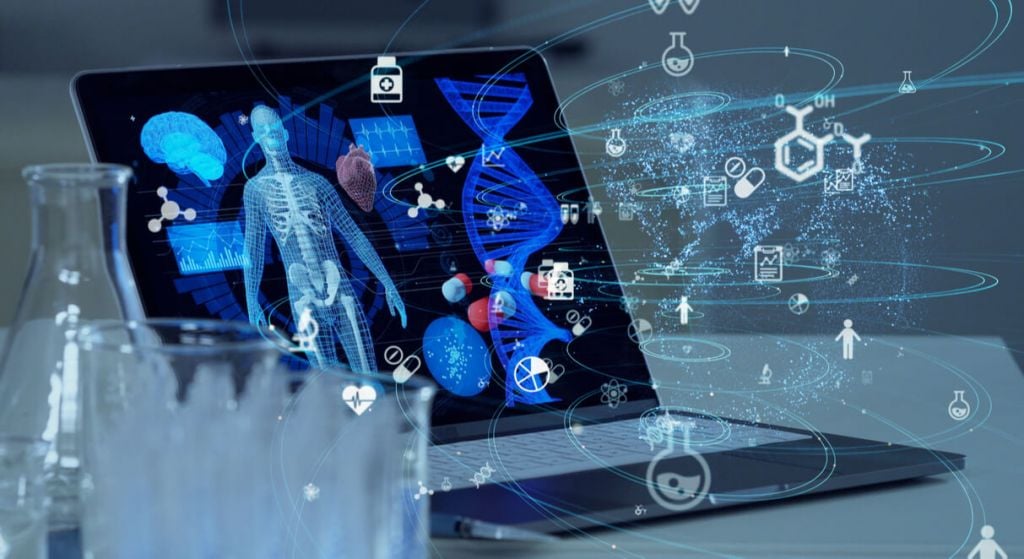Artificial intelligence (AI) has become a part of everyday modern life and continues to generate excitement. In this article, we will take a look at how biotechs are advancing into AI-facilitated early drug design, its real-world outcomes so far, and whether it is living up to its potential in the life science industry.
AI enables computers and machines to learn from past behavior and mistakes, much like humans can. From search algorithms to self-driving cars and Siri, it is cemented in our daily lives.
In complex drug discovery, AI has the potential to make processes faster and more cost-effective, with the hope of reducing the time a new drug needs to reach the patient. The optimism surrounding AI has increased attention towards the technology from the life sciences industry.
Data scientists have become highly sought after, and AI-driven life science startups raised €8.45B ($10B) from 2015 through the first half of 2021.
In the current pandemic, AI has been successfully used to identify potential drugs that could be used to treat Covid-19. Recently, Google’s Deepmind AI system AlphaFold has found a solution to how proteins fold into their 3D structure, which may create new opportunities in structure-based drug design.
The challenges of using AI in drug discovery
However, today, drug discovery researchers still face a number of challenges.
“Overall, the convergence of AI and life sciences, and AI in drug discovery specifically, is a new field,” said Daniel Cohen, CEO and Founder of Valence Discovery, an AI drug design company based in Canada. “A big sticking point is just the lack of datasets of sufficient size and quality that exist in a typical drug discovery program.”

Valence Discovery
Moreover, it can be difficult to pinpoint what AI-powered tools can or cannot realistically achieve in drug discovery at the moment.
As a result, unrealistic expectations have arisen among industry insiders. Disappointments with AI partly come from the misconception that it is a ‘magic bullet’ for all of drug discovery’s challenges.
“There is always a bigger gap than people outside the space realize, especially between advances in fundamental machine learning research and what it takes to get the most out of these methods in practice,” Cohen explained.
Finding hits and inventing molecules
Despite the challenges it faces, AI in drug discovery is making significant steps in the right direction.
“We are beginning to see successes. Of course, it’s going to take time for reality to meet expectations. In general, AI applications in drug discovery and medicinal chemistry is a field that is progressing really fast,” Cohen said.
Two areas of drug discovery where AI already is a powerful tool are hit identification and de novo molecular design.
Hit identification searches libraries for pre-existing compounds that could be viable active ingredients in new drugs similar to a trial and error process.
De novo molecular design is a method by which new, unique molecules are created computationally from scratch. AI can potentially analyze and tailor chemical properties more thoroughly and quickly than teams of scientists using traditional methods can.

“AI applied to hit identification and de novo molecular design can explore real vast areas of chemical space, and generate molecules that can actually be synthesized in the laboratory,” explained Grant Wishart, Director of Computer-Aided Drug Design at Charles River Laboratories.
A common limitation of AI-driven drug discovery is that the chemical reactions involved in creating a potential drug candidate are unknown, which makes the actual laboratory synthesis of the compound challenging.
“This has been a major roadblock in this field,” said Cohen.
An AI partnership paves the way for better drug discovery
Earlier this year, Charles River announced a partnership with Valence Discovery. The collaboration will use AI to improve how Charles River helps clients with new and pre-existing drug discovery programs.
“At Charles River, we think that AI has major potential to enhance our science and impact our client projects. We were specifically looking for a partner in the de-novo design space and felt that Valence’s technology and creativity was an excellent fit for a seamless collaborative experience,” said Wishart.
In particular, Valence is addressing two key challenges in AI-driven drug discovery: working with limited data and designing compounds that can actually be synthesized in the lab.
For example, Valence Discovery’s REACTOR technology models the series of chemical reactions leading to a potential drug candidate’s creation in addition to the molecule itself.
“What is unique about Valence is that we’re the first company to bring techniques for low data learning to drug design, and have developed technologies to design high-quality molecules, optimized for multiple parameters, that can be readily synthesized,” Cohen elaborated.
Valence uses so-called few-shot learning algorithms, which analyze small and large datasets to explain the connections between molecular structure and bioactivity. This includes properties and targets out of reach of existing deep learning algorithms.
Hence, Valence’s technology can help predict important properties of and relationships between compounds that may escape human chemists or other AI-driven approaches.
By combining AI-driven insights with the intuition of experienced chemists, AI tools can be used to rapidly and cost-effectively find or create new, effective drug-like compounds.
An exciting future for AI-driven drug discovery

“We want to input the parameters our molecules should satisfy, and be able to efficiently generate novel molecules to meet those parameters,” explained Cohen.
This approach, called multiparameter optimization, could improve a drug’s target selectivity, and lower toxicity by minimizing unwanted interactions with off-targets.
Furthermore, multiparameter optimization can lower the number of compounds synthesized to find potential drug candidates. It can also decrease the number of design cycles a drug candidate goes through in order to be validated.
AI is unlikely to completely replace human ingenuity in drug discovery any time soon. Closer collaboration, trust, and crosstalk between AI engineers and life scientists are essential to realizing its full potential in drug discovery.
As AI engineers become fluent in natural science and life scientists understand it better, the real impact of AI on drug discovery will begin to emerge.
If you’ve entered the AI waters before and were disappointed or were hesitant to dip your toes in, now is the time to look again. Explore what AI offers today and expand your horizons and R&D portfolio. Ask Charles River what AI can do for you!
Images via Shutterstock.com





